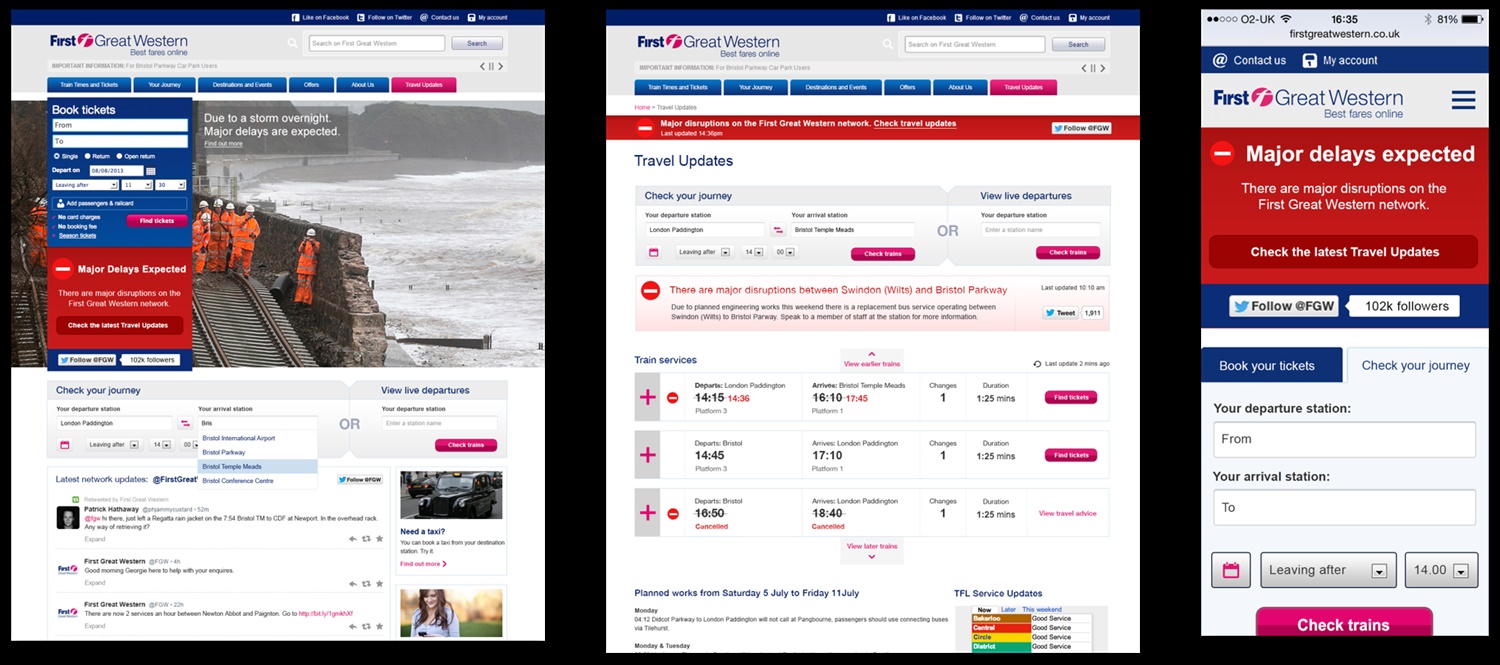01.03.15
Transparent and honest information during disruption
Source: Rail Technology Magazine Feb/March 2015
First Great Western overhauled the way it communicates with passengers online during disruption – and was put to the test almost immediately by the Christmas chaos. RTM spoke to the operator’s digital marketing manager, Jason Ali.
After 18 months of development, including 12 months of customer research and interviews, First Great Western (FGW) has gone live with its new webpage for ‘travel updates’.
It was the brainchild of digital marketing manager Jason Ali, who decided when he joined the company from Heathrow Express in April 2012 that change was needed. The old page featured no journey planning tool, poor information during disruption, and basically forwarded passengers to National Rail Enquiries (NRE).
“There was a lot of pressure on me at the time both to innovate and to get FGW up to industry standards,” Ali told RTM.
The company embarked on its Passenger Information During Disruption (PIDD) initiative knowing that almost a quarter of passengers rate the way TOCs deal with delays as ‘poor’. FGW’s mixed-use network made targeted messaging essential – it is split between commuters using it for work every day (especially from Swindon and Oxford and Reading into London) and long-distance leisure travellers.
Ali said: “FGW is the largest and most complex network in the UK. A lot of people only see us as a commuter franchise, because the commuters shout the loudest. But our audience is made up of 50% leisure, 50% commuter, which is a daily challenge for me in my role: our digital touchpoint needs to be balanced to represent those two audiences.”
Creating what customers wanted
A vast range of qualitative and quantitative data was assembled, including 250 customer interviews and data segmented by demographics – students, retired people, young professionals and families, for example.
“That helped us create a prioritised roadmap of initiatives. This project was all about listening to customers, and how we could use our digital expertise to create what customers wanted,” Ali said. The ‘travel hub’ was the first in the industry to combine feeds to give passengers “unprecedented access” to real-time train schedules and running data, live departure boards and re-routing information, with a focus on being “honest and transparent”. Twitter is integrated, as are TfL service updates London, and it can give a personalised response to disruptions.
A better website is essential during disruption, but also useful day-to-day – it helps passengers but also reduces pressure on staff and managers.
Ali said: “The results so far have been phenomenal – I did not expect it to be this successful, in terms of sentiment and analytics and usage. It’s been extraordinary.”
When RTM spoke to Ali in January, the feedback figures were already good: 73% said the site was ‘extremely easy’ to use, and usage shot up 355%. Ali thanked FGW’s digital agency, ORM, with whom he said he shared a focus on data and a customer-centric way of working. Lorenzo Vasini, ORM business development director, said: “Detailed user testing was vital to designing a platform that will improve customer satisfaction when delays occur.”

Trial by fire
The soft launch was on 9 November, but from 18 December, once the site had had some time to bed in and for teething troubles to be fixed, the company started marketing it more proactively and also asking for online feedback.
This facility was put to unexpected use on 27 December when over-running engineering work at Old Oak Common caused chaotic disruption at Paddington and west of London.
Ali explained: “I was in work that day. Because we had the survey on the website for customers to give us feedback on the [web] enhancements, lots of people used that form to give us feedback in real time about their experiences. I could see all that feedback coming in, real time, and where customers were having technical issues, I was fixing them in real-time.”
One fault occurred whenever people tried to include extra stations when using the journey planner, which Ali fixed there and then.
The site’s next step is more personalisation – for example, it will automatically remember your last five journeys and offer relevant information based on them.
One-stop-shop
We asked Ali whether the project was a deliberate attempt to keep users on the FGW site rather than have them use NRE.
He said: “That was part of the vision and aim for this project. We believe we can provide our customers with the best source of information. We’ve seen already a 10% drop-off rate from customers going to NRE through our website.”
 The website is just part of the story, of course: Ali said the ‘holy grail’ was a single source of truth, where the same correct information is presented to everyone, everywhere, at the same time – online, on the platform, on board the train, and so on.
The website is just part of the story, of course: Ali said the ‘holy grail’ was a single source of truth, where the same correct information is presented to everyone, everywhere, at the same time – online, on the platform, on board the train, and so on.
He said: “As we all know, technology is great when it works – but when it doesn’t, it creates challenges. We have a lot of back-up plans, so if the feeds fail, we have ways within our content management system that our control team and customer response team can go and update things. It’s a very robust system.”
Tell us what you think – have your say below or email [email protected]